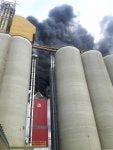Anyone know what actually caused this dryer fire at humboldt?
Also what were they drying?
Things I always watch out for:
* chaff inside heating chamber
* chaff recirculated on top of dryer
* plugged off/restricted exhaust vents
Any others one should be looking out for? Not sure how I get so much chaff in the drying chamber, yet nothing much comes out of the exhaust ports.
Would be nice if there was a fire detection unit that could be installed, as running all night a guy can't watch it 24/7.
Also what were they drying?
Things I always watch out for:
* chaff inside heating chamber
* chaff recirculated on top of dryer
* plugged off/restricted exhaust vents
Any others one should be looking out for? Not sure how I get so much chaff in the drying chamber, yet nothing much comes out of the exhaust ports.
Would be nice if there was a fire detection unit that could be installed, as running all night a guy can't watch it 24/7.





